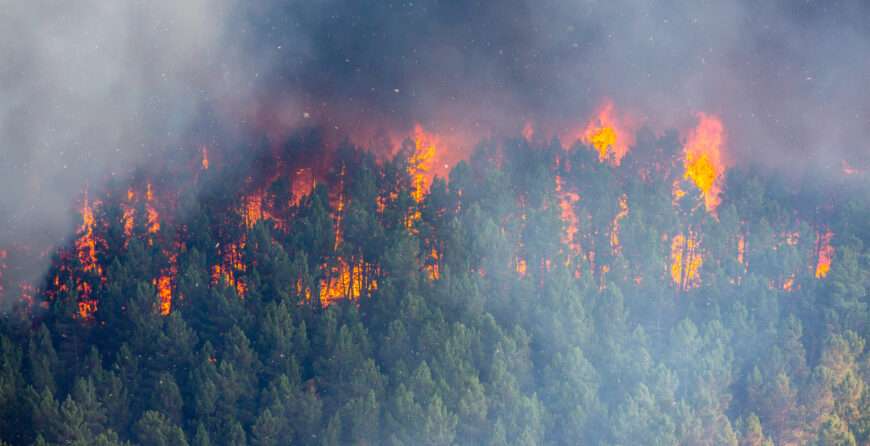Walking through the bush lately, one thing is hard to ignore—how dry the ground has become. We’re in the middle of another drought here in Ontario, and you can see it first-hand when pushing dirt during a clearing. The soil isn’t holding moisture, and when the rain does come, most of it barely reaches the ground. Thick canopies keep water from ever soaking in, and the trees themselves compete for what little does make it through.
That’s where selective thinning comes in. It’s not about clear-cutting or stripping the land bare—it’s about removing the weak, dead, and overcrowded trees so the forest as a whole can breathe and recover. By opening the canopy, more rainfall actually gets down to the soil. During dry years, that can mean the difference between a forest that survives and one that becomes a tinderbox.
Ontario’s Drought Reality
This isn’t a one-off event. Ontario has endured several historic droughts across the 20th century—examples include the severe dry spells of 1930, 1933–34, 1936, 1963, 1998, and 1999, which heavily impacted southern regions (source). More recently, in 2023, much of Canada, including Ontario, faced one of the most widespread droughts in decades, triggered by rapid snowmelt and one of the warmest spring seasons on record (source). And as we’ve seen in 2025, droughts are only becoming more frequent, putting extra strain on our forests and communities.
The Spruce Budworm Factor
On top of drought, our forests have been fighting another battle: the spruce budworm. This small insect has killed millions of spruce and fir trees across Ontario and Quebec (Natural Resources Canada). When you drive through stretches of bush and see the endless patches of grey, dead trees, that’s the budworm’s work. And all those dead standing trees? They’re nothing but fuel waiting for a spark.
Combine that with drought-dried soil and overcrowded stands, and you’ve got the perfect recipe for disaster. Thinning helps take that fuel load out of the equation, reducing the chance of small fires turning into massive, uncontrollable ones.
Fire Prevention and Slowing the Spread
No system is perfect, but thinning is one of the most effective tools we have for fire prevention. By reducing canopy density and cleaning up deadwood, we make it harder for fires to climb into the treetops and spread uncontrollably. Even if a fire does break out, a properly thinned forest can slow it down, giving firefighters a fighting chance and protecting nearby communities.
Research shows that thinning, especially when paired with controlled burns, can reduce the severity of crown fires for decades (Fire Ecology Journal). That’s not just theory—that’s boots-on-the-ground results.
Healthy Forests, Healthy Soil
Beyond fire, thinning also helps the forest itself. Overcrowded stands mean trees fight for every drop of water and ray of sunlight. By removing the weaker ones, the healthier trees can thrive. The soil benefits too—rainfall has a better chance to soak in, roots get stronger, and the overall ecosystem becomes more resilient.
Studies also show that selective thinning improves long-term stand stability and even enhances carbon storage compared to clearcutting (Springer). It’s about working with the land, not against it.
Lessons From the Past
Ontario has seen what happens when we ignore these risks. The Porcupine Fire of 1911 burned nearly 200,000 hectares and claimed dozens of lives during a dry summer (source). The Matheson Fire of 1916 destroyed entire towns and killed more than 200 people (source). Then in 1922, the Great Fire of Timiskaming destroyed 246,000 hectares, a direct result of dry conditions and fuel-loaded forests (source).
Even in recent years, Ontario has faced destructive fires, such as the Parry Sound 33 fire in 2018, which forced evacuations and burned over 11,000 hectares (source). The lesson is the same: drought plus unmanaged fuel loads equals disaster.
Moving Forward
Selective thinning isn’t a quick fix, and it’s not about turning forests into open fields. It’s about balance. By managing our forests smartly—removing the dead and overcrowded trees, addressing threats like the spruce budworm, and allowing the soil to recharge—we give these ecosystems a fighting chance against drought, pests, and fire.
The reality is clear: droughts will come again, pests like the budworm will return, and wildfires will always be a risk. But through proactive management, we can reduce the damage, protect our communities, and keep Ontario’s forests strong for generations to come.
Call to Action
If you own property, manage land, or are considering new development, now is the time to think about proactive forest thinning. Don’t wait for drought or fire to make the decision for you.
Call Canada Brush Control today—we’ve got the experience, the equipment, and the knowledge to help you clear safely, selectively, and responsibly. Every healthy forest and every dream build starts with a clean slate—we help uncover it, one tree at a time.


